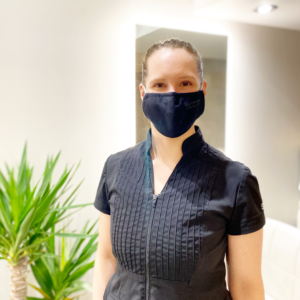What is Dermaplaning?
Dermaplaning – is it a facial exfoliating treatment or hair removal technique?
Christine Fader, Master Esthetician at Spirit Spa and skin guru, gives us the inside scoop on dermaplaning, the benefits and why you should not try this at home.
Q. Is dermaplaning a skin exfoliation or hair removal treatment?
It’s both! I love double-duty skin treatments. Dermaplaning removes built-up dried, dead skin cells and the fine peach fuzz hair also known as vellus hair, says Fader.
Dermaplaning is performed at a clinical spa or a dermatologist’s office, although there are some devices you can use at home as well. At Spirit Spa, our estheticians use a sterilized medical-grade scalpel with a rounded edge and gently rock the blade back and forth across the skin at a 45-degree angle, says Fader. This technique removes the epidermis’ top layers and softens the appearance of scars and wrinkles, revealing newer skin cells beneath. This treatment doesn’t use any products to exfoliate the skin, so it is ideal for pregnant women and anyone who has sensitive skin.
Your esthetician will assess your skin prior to the treatment as part of a consultation. Dermaplaning can be done independently or as part of a facial treatment and takes 30 mins. Before going in for a treatment, you want to be consistent with your sunscreen and avoid the treatment if you have a sunburn or really dehydrated skin.
Q. What are the benefits of dermaplaning?
This is a resurfacing treatment, so the look of fine lines and any acne scarring diminishes, skin looks smoother and more radiant. Wrinkles often have compacted dead skin cells built up, so by taking a good layer of dead skin cells off; it will smooth the wrinkle out. It’s not permanent but it helps with the appearance of fine lines.
The other huge benefit is that it helps your skincare ingredients sink in better – resulting in plump and dewy-looking skin. The lack of those fine hairs also allows makeup to sit better on the skin. The effects of dermaplaning last between three weeks to a month.
Q. Does the facial hair grow back thicker?
One of the common misconceptions about dermaplaning is that it will make your hair grow back thicker and darker. This is a myth, says Fader. With this treatment, we are shaving the hair off at the base and not interfering with the follicle structure under the skin, which means hair will grow back at the same rate, width and texture.
Q. How do you take care of your skin after dermaplaning?
The new baby soft skin after dermaplaning needs to be protected. Shield your skin from UVA/UVB rays by applying a mineral-based sunscreen each time you leave the house and reapply often. Most of my clients use Colorescience – All Calm Clinical Redness Corrector SPF 50. This 3-in-1 formula instantly neutralizes redness, helps soothe and calm sensitive skin, and provides SPF 50 protection. It is specially formulated for post-cosmetic procedure care.
Pro Tip: Minimize the use of retinol and glycolic acids for about a week after your treatment and moisturize, moisturize, moisturize!
Q. Should you try dermaplaning at home?
Dermaplaning at home has become one of the most searched terms on Google. With spas and dermatologist offices shut down, at home treatments sprung up.
There are a few at-home dermaplaning kits and tools, but because you are using a blade on the skin, there is a risk of cutting yourself which can lead to scarring. Better to be safe and get the full benefits of dermaplaning from a trained esthetician or dermatologist
Q. Is Dermaplaning right for you?
If you are unsure if this is right for you, our Spirit Spa estheticians are a virtual consult away. This treatment is painless and doesn’t have any downtime and can be a great compliment to your skincare regime.
Have more questions?
We are here to help. Please email us at hello@spiritspa.ca






